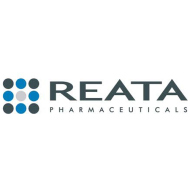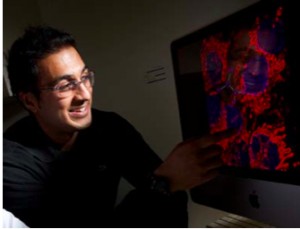Reata Begins Enrollment For PAH – LARIAT Phase 2 Study Examining Bardoxolone Methyl for Treating Pulmonary Arterial Hypertension

 Irving, Texas based Reata Pharmaceuticals, Inc. has enrolled the first patient in a Phase 2 dose ranging study examining the safety, tolerability, and efficacy of bardoxolone methyl in patients with pulmonary arterial hypertension (PAH).
Irving, Texas based Reata Pharmaceuticals, Inc. has enrolled the first patient in a Phase 2 dose ranging study examining the safety, tolerability, and efficacy of bardoxolone methyl in patients with pulmonary arterial hypertension (PAH).
PAH is a life-threatening disease involving endothelial dysfunction, vasoconstriction in small pulmonary arteries, aberrant proliferation of certain vascular cells, and dysregulated inflammatory signalling leading to vascular remodelling, pulmonary fibrosis, and right ventricular enlargement. PAH has been estimated to affect 15 to 20 thousand people in the United States, predominantly middle-aged women. Available treatments for PAH can provide symptomatic improvement, primarily by relieving vasoconstriction (e.g., by inhibiting signalling in the endothelin-1 pathway), but they do not directly suppress inflammation or proliferation pathways and the disease continues to progress. Consequently, there is a very high unmet clinical need for new therapy; PAH has a high mortality rate with 60 to 80 percent of patients dying within five years of diagnosis.
[adrotate group=”4″]
The U.S. National Library of Medicine (NLM) describes pulmonary arterial hypertension as abnormally high blood pressure in the arteries of the lungs that makes the right side of the heart work harder than normal. The right side of the heart pumps blood through the lungs, where it picks up oxygen. Blood returns to the left side of the heart, where it is pumped to the rest of the body. When the small arteries (blood vessels) of the lung become narrowed, they cannot carry as much blood. When this happens, pressure builds up — called pulmonary hypertension. The heart needs to work harder to force blood through the vessels against this pressure, and over time, this causes the right side of the heart to become larger. Ultimately, heart failure affects the right side of the heart. This is called cor pulmonale.
The NLM says pulmonary hypertension may be caused by autoimmune diseases that damage the lungs, such as scleroderma and rheumatoid arthritis, birth defects of the heart, blood clots in the lung (pulmonary embolism), heart failure, heart valve disease, HIV infection, low oxygen levels in the blood for a long time (chronic), lung disease, such as COPD or pulmonary fibrosis, medicines (for example, certain diet drugs), and obstructive sleep apnea, but in many patients, the cause of pulmonary hypertension is unknown in the modern era. In that case, the condition is called idiopathic pulmonary arterial hypertension (IPAH). IPAH is rare, and affects more women than men. If pulmonary hypertension is caused by a known medicine or medical condition, it is called secondary pulmonary hypertension.
In a Perspective paper published in the journal Cell Metabolism, entitled “The Metabolic Basis of Pulmonary Arterial Hypertension” (Cell Metab. 2014 Apr 1;19(4):558-73. doi: 10.1016/j.cmet.2014.01.004. Epub 2014 Feb 60), Dr.  Gopinath Sutendra and Professor of Medicine Evangelos D. Michelakis of the University of Alberta Department of Medicine in Edmonton, Canada, describe pulmonary arterial hypertension as a vascular remodeling disease of the lungs resulting in heart failure and premature death, noting that while until recently, it was thought that PAH pathology is restricted to pulmonary arteries, it is now known that several extrapulmonary organs are affected as well.
Gopinath Sutendra and Professor of Medicine Evangelos D. Michelakis of the University of Alberta Department of Medicine in Edmonton, Canada, describe pulmonary arterial hypertension as a vascular remodeling disease of the lungs resulting in heart failure and premature death, noting that while until recently, it was thought that PAH pathology is restricted to pulmonary arteries, it is now known that several extrapulmonary organs are affected as well.
 Drs. Sutendra and Michelakis observe that the realization that these tissues share a common metabolic abnormality (i.e., suppression of mitochondrial glucose oxidation and increased glycolysis) is an important element in our understanding of PAH, if not a paradigm shift, and in their paper they discuss an emerging metabolic theory, which proposes that PAH should be viewed as a syndrome involving many organs sharing a mitochondrial abnormality and explains many PAH features and provides novel biomarkers and therapeutic targets.
Drs. Sutendra and Michelakis observe that the realization that these tissues share a common metabolic abnormality (i.e., suppression of mitochondrial glucose oxidation and increased glycolysis) is an important element in our understanding of PAH, if not a paradigm shift, and in their paper they discuss an emerging metabolic theory, which proposes that PAH should be viewed as a syndrome involving many organs sharing a mitochondrial abnormality and explains many PAH features and provides novel biomarkers and therapeutic targets.
The coauthors explain that the definition of PAH and the spectrum of associated conditions has been changing in part because of improved ability to diagnose it earlier and more accurately. Although its exact incidence and prevalence remain unknown in the modern era, PAH appears to be more prevalent than previously thought. However, they note that because of its high mortality, the relatively young age of affected patients, and the very high cost of available therapies, this disease has a significant impact on society. For example, the mortality of severe PAH is similar to that of metastatic breast cancer, whereas the currently estimated cost of treatment for advanced PAH exceeds $200,000 per patient a year (Chen et al., 2009). Approved treatments for PAH, including endothelin receptor antagonists, phosphodiesterase inhibitors, and prostanoids, relieve vasoconstriction but do not have direct effects on other aspects of the disease. Thus, current therapies for PAH remain poor in terms of their ability to reverse the disease or significantly delay its progression.
However, an extensive body of research by leading academics and in-house Reata scientists has demonstrated that bardoxolone methyl and related compounds have highly potent antioxidant and anti-inflammatory properties, including beneficial effects on endothelial dysfunction, as well as anti-proliferative and anti-fibrotic effects.
[adrotate group=”3″]
Additionally, NF-κB, another transcription factor activated in response to inflammation, is broadly inhibited by bardoxolone methyl. Previous studies have shown NF-κB suppression reduces smooth muscle cell proliferation, attenuating restricted blood flow in the pulmonary arteries. Further, bardoxolone methyl is unique to other existing therapies because it targets more than smooth muscle cells. Endothelial cells, macrophages, and smooth muscle cells are all affected, allowing the multiple facets of PAH pathophysiology to be addressed.
Reata’s New Approach for Treating PAH
Reata is a leader in developing a novel class of drugs with potent transcription-regulating activity, called antioxidant inflammation modulators (AIMs). AIMs activate the biological transcription factor Nrf2, promoting the production of numerous antioxidant, detoxification, and anti-inflammatory genes, and inhibit NF-kB, a gene that regulates many pro-inflammatory proteins. Nrf2 controls the body’s production of hundreds of antioxidative and cytoprotective molecules and is associated with protection against a broad range of diseases involving inflammation and oxidative stress. Activation of Nrf2 promotes the production of numerous antioxidative, detoxifying, and anti-inflammatory genes and moreover, inhibits NF-kB, a gene that regulates many pro-inflammatory proteins. The pharmacology of the AIMs mimics that of endogenous prostaglandin metabolites that are responsible for the orchestrated resolution of inflammation. The anti-inflammatory, cytoprotective, and energy metabolism effects of AIM pharmacology have been documented in more than 250 scientific papers and are potentially relevant to a wide range of diseases.
Bardoxolone methyl (formerly RTA 402) was the initial AIM, partnered with Kyowa Hakko Kirin and AbbVie through deals finalized in 2009 and 2010, and the collaboration with AbbVie was expanded to the AIM platform through a deal finalized in 2011. These collaborations have led to a number of programs in the clinic today.
RTA 408, a follow-on molecule related to bardoxlone methyl, is in planning for a Phase 1b/2 trial in melanoma and lung cancer beginning in 2014 to test the ability to augment checkpoint inhibitors such as ipilimumab and PD1 inhibitors. RTA 408 is also in planning for testing of its anti-inflammatory and bioenergetics effects in Phase 2 trials for the treatment of Freidreich’s Ataxia and Mitochondrial Myopathies during the second half of 2014.
“AIMs promote normal vasodilatory tone by restoring endothelial function and suppressing vasoconstrictive endothelin signalling. While this activity should complement available PAH therapies, through inhibition of pro-inflammatory NF-kB signaling bardoxolone methyl also directly suppresses inappropriate proliferation, which is not directly affected by currently approved products,” says Reata’s Chief Medical Officer Dr. Colin Meyer. “Additionally, preclinical studies have shown that Nrf2 activation positively regulated mitochondrial function, promoting increased cellular energy production. This is reduced in many PAH patients and results in significant fatigue and functional impairment.”
Reata’s LARIAT Trial
Reata’s LARIAT trial is a phase 2, multi-center, double-masked, randomized, dose-ranging, placebo-controlled study. The primary efficacy endpoint is a six minute walk test. The study, which is currently recruiting more participants, will also explore changes from baseline in cardiopulmonary exercise testing, cardiac magnetic resonance imaging, parameters collected during Doppler echocardiography and other measures.
This study assesses the safety and efficacy of bardoxolone methyl relative to placebo in patients with pulmonary arterial hypertension to determine the recommended dose range and evaluate the change from baseline in 6-minute walk distance (6MWD) following 16 weeks of study participation.
Reata notes that the molecular and pharmacological effects of bardoxolone methyl are broad through its induction of Nrf2 and suppression of NF-kB, explaining that bardoxolone methyl may therefore address multiple facets of the pathophysiology of PAH because in non-clinical studies it suppresses activation of pro inflammatory mediators, enhances endothelial NO bioavailability, improves metabolic dysfunction, suppresses vascular proliferation, and prevents maladaptive remodeling. Furthermore, while existing therapies primarily target only smooth muscle cells, bardoxolone methyl targets multiple cell types relevant to PAH, including endothelial cells, smooth muscle cells, and macrophages.
The LARIAT study is divided into two parts:
Part 1 of the study will include both dose-escalation and expansion cohorts.
Part 2 (extension period): All patients from Part 1 who complete the 16-week treatment period as planned will be eligible to continue directly into the extension period to evaluate the intermediate and long-term safety and efficacy of bardoxolone methyl.
For more information on the study, visit:
https://clinicaltrials.gov/show/NCT02036970
Antioxidant Inflammation Modulators (AIMs): What You Need To Know
According to Reata, in vitro studies have shown that unlike most drugs, which are directed at a single molecular target, AIMs affect the activity of major transcription factors with complex downstream effects that influence the expression of hundreds of genes, and work by binding to critical regulatory cysteine residues on Keap-1, a protein that is the major negative regulator of the transcription factor Nrf2. Binding of AIMs to Keap-1 promotes translocation of Nrf2 to the nucleus, where it stimulates the production of a wide variety of proteins with antioxidative, anti-inflammatory, and cytoprotective properties1,2.
One of the primary effects of Nrf2 activation is reduced production of reactive oxygen and nitrogen species (ROS/RNS) such as superoxide, hydrogen peroxide, and peroxynitrite. A number of medicinal natural products, including oleanolic acid (the source material for AIMs), resveratrol and curcumin, also have modest Nrf2-activating properties, but AIMs are by far the most potent known activators of Nrf2. AIMs also inhibit the activity of the major pro-inflammatory transcription factor NF-kB, both directly (by inhibiting IKK, the kinase that activates NF-kB) and indirectly (by inhibiting ROS/RNS-mediated signaling pathways that promote NF-kB activity)3,4. This pharmacology mimics that of endogenous prostaglandin metabolites (e.g., 15-deoxy prostaglandin J2) that are responsible for the orchestrated resolution of inflammation.
Reata says the effects of AIM pharmacology have been documented in more than two hundred scientific papers and are relevant to a wide range of diseases, and AIMs have well-documented effects on multiple processes that are implicated in PAH7. These include:
• Improvement of vascular endothelial dysfunction caused by excessive ROS production
• Inhibition of proliferative signaling mechanisms;
• Inhibition of endothelin-1 signaling that promotes vasoconstriction;
• Inhibition of inflammatory signaling pathways that promote tissue remodelling; and
• Promotion of normal energy metabolism, which is frequently impaired in skeletal muscle of PAH patients.
Anti-inflammatory Effects
Inhibition of inflammatory cytokine signaling: In many different disease models, AIMs suppress ROS-mediated production of TNF, IL-6, IL-1, IFN, IL-17 and other inflammatory cytokines. Because many of these cytokines generate ROS by binding to their target receptors, AIMs inhibit their downstream signaling pathways as well as their expression.
Inhibiting ROS/RNS-mediated effects of excessive inflammatory response: Among the earliest described effects of AIMs was the inhibition of nitric oxide (NO) production by activated macrophages, which results from reduced expression of inducible nitric oxide synthase (iNOS).
Overproduction of NO can stimulate production of other ROS/RNS such as superoxide and peroxynitrite, resulting in pathological damage to many different macromolecules. AIMs reduce markers of protein nitration and lipid peroxidation and increase the expression of proteins required to minimize oxidative stress from iron and heme metabolism (e.g., heme oxygenase, biliverdin reductase, and ferritin).
[adrotate group=”3″]
Energy Metabolism And Mitochondrial Function
Nrf2 transcriptionally regulates multiple genes that play both direct and indirect roles in the production of cellular energy (i.e., adenosine triphosphate or ATP) within the mitochondria2. Consequently, unlike exogenously administered antioxidants (e.g., vitamin E or derivatives), which provide a specific and finite antioxidative potential, AIMs broadly activate intracellular and mitochondrial anti-oxidative pathways, in addition to pathways that may directly increase mitochondrial biogenesis and bioenergetics.
Activation of the Nrf2 pathway increases the efficient use of fuel (fatty acids and glucose) by mitochondria and increases basal oxygen consumption. Nrf2 activation results in improved beta-oxidation of fatty acids and improved uptake of glucose, thereby improving mitochondrial respiration, oxygen consumption, and energy production2. AIMs increase oxygen consumption, reduce insulin resistance, and improve glucose clearance in animal models of diet-induced obesity and diabetes. Positive effects on glucose clearance, and significant weight loss, have also been demonstrated in clinical trials of bardoxolone methyl in patients with Type II diabetes.
Activation of the Nrf2 pathway may also increase mitochondrial number via induction of a central inducer of mitochondrial biogenesis. The number of mitochondria and mitochondrial-related proteins within skeletal muscle fibers can increase (mitochondrial biogenesis) in response to regular exercise, resulting in increased basal oxygen consumption and energy production. PGC1 is a master transcriptional coactivator and central inducer of mitochondrial biogenesis. PGC1 expression in skeletal muscle is increased in response to activation of Nrf2 signaling. Consequently, Nrf2-mediated induction of PGC1 by AIMs is hypothesized to increase mitochondrial biogenesis and energy production.
Activation of Nrf2, through its antioxidative effects, balances reducing equivalents and maintains mitochondrial homeostasis and efficiency. The primary role of mitochondria is the generation of energy in the form of ATP. Mitochondrial ATP production occurs through the flow of electrons derived predominately from intermediates of the tricarboxylic acid cycle. During the transfer of electrons along the electron transport complexes in the mitochondria, single electrons escape and result in production of ROS. Mitochondria possess multiple antioxidative defense systems, which produce reducing equivalents such as NADH and FADH2 to counteract the abundance of ROS that are formed. The management of these reducing equivalents is a constant and critical balancing act within the mitochondria. Mitochondrial reducing equivalents can either be consumed by the electron transport chain to produce energy via ATP, or consumed as cofactors to defend against oxidative stress. Disease processes that increase oxidative stress serve to deplete mitochondrial reducing equivalents and reduce ATP production. Therefore, by increasing the availability and production of reducing equivalents such as NADH and FADH2, Nrf2 activation increases mitochondrial ATP production and improves the efficiency of mitochondrial respiration and oxygen consumption.
Sources:
Reata Pharmaceuticals, Inc.
Cell Metabolism
European Respiratory Journal
U.S. National Library of Medicine
University of Alberta
Image Credits:
University of Alberta







